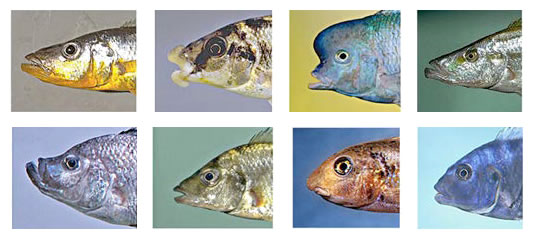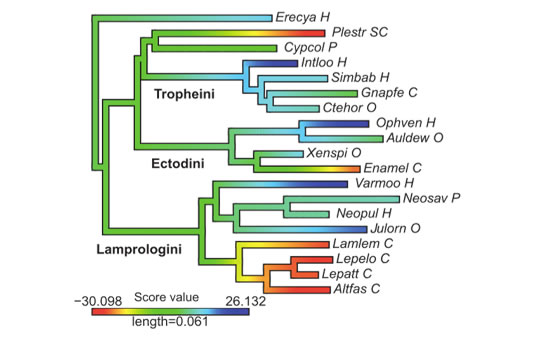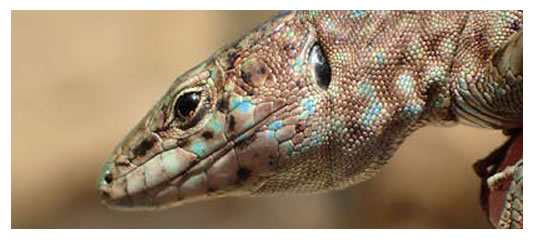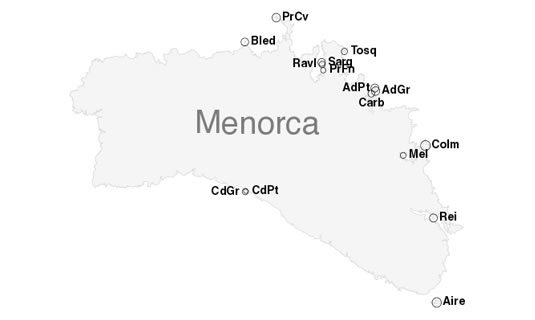A most fascinating symbiosis has evolved between all living organisms and complex microbial communities, dating back to the very beginning of life. During the past few years, thanks to the advent of metagenomics, we have started to reveal the diversity, complexity and impact of these host-associated microbiotas, bringing a new perspective into the organismal biology, ecology and evolution.
Now, we are faced with the great challenge of integrating this “novel” trait into our understanding of how living organisms, as symbiotic ecosystems, diversified and adapted to their ecological environment. Our research team is trying to address this challenge.
THE GUT MICROBIOTA
The intestinal tract of all animals contains the richest and most abundant consortium of microorganisms, known as the gut microbiota. These complex microbial ecosystems, predominantly composed by bacteria, are intricately associated with their hosts and participate in fundamental biological aspects of their hosts, including digestion, immune response, development, behavior, life cycle and mating preferences.
At an evolutionary timescale, estimating how much of the extant gut microbiota diversity is associated to ecological, environmental or host-related constraints (e.g. genotype) remains a major challenge.
OUTSTANDING QUESTIONS:
- What is the level of host-specificity of the gut microbiota?
- To what extent these microbial communities have coevolved with their hosts?
- How much of the gut microbiota variability is adaptive?
- Have changes in gut microbiota played a role in the process of host adaptation/diversification?
We addressed these questions through metagenomics analyses using two natural model systems:
- The cichlid fishes, a primary vertebrates model system for the study of adaptive radiations and rapid sympatric speciation. The system hosts multiple species that have diversified along a dietary gradient, making the study of the gut microbiota particularly relevant in the evolution of these fishes.
- The Podarcis lilfordi lizard from the Balearic Islands, an example of incipient speciation in allopatry. This endemic species is currently present in coastal islets of Mallorca and Menorca, and Cabrera. Presence of multiple islets/islands, each hosting a geographically and reproductively isolated population, makes this a powerful system to study recent microbiota dynamics at host intraspecific level and the potential “island” effects on these microbial consortia.
ROLE OF THE GUT MICROBIOTA IN THE ADAPTIVE RADIATIONS OF CICHLID FISHES
Cichlid fishes represent the greatest adaptive radiation among vertebrates, largely driven by adaptation to a wide range of trophic niches. The system is ideal for investigating the eco-evolutionary dynamics of the gut microbiota in presence of i) strong host phylogenetic relatedness (i.e. genetic constraints), ii) rapid dietary shifts, and iii) natural parallelisms in trophic adaptation. Particularly interesting is the repeated evolution of herbivory, which involves major morphological, behavioral and metabolic changes.
We are currently studying cichlids from Africa (lake Tanganyika and Barombi Mbo) and Nicaragua (Midas cichlid complex) (multiple lakes), encompassing multiple species and dietary niches.
Ongoing research focuses on the following questions:
a) Does the gut microbiota behave as a trophic trait? Specifically, does it shows evidence of convergence/divergence as a function of cichlid diet?
b) Did the gut microbiota act as a driver of the cichlid extraordinary dietary adaptation?
c) What is the metabolic contribution of the gut microbiota to the evolution of herbivory in cichlids?
We use comparative metagenomics and multivariate statistical analyses to adress these questions. Targeted experimental approaches are being developed in collaboration with the University of Cambridge (UK).
Recent articles on the topic:
- Baldo L, Riera JL, Salzburger W and Barluenga M (2019). Phylogeography and ecological niche shape the cichlid fish gut microbiota in Central American and African lakes. Frrontiers in Microbiology | https://doi.org/10.3389/fmicb.2019.02372
- Baldo L, Pretus JL, Riera JL, Musilova Z, Bitja Nyom AR, Salzburger W (2017) Convergence of gut microbiotas in the adaptive radiations of African cichlid fishes. ISME J. DOI: 10.1038/ismej.2017.62
- Baldo L, Riera JL, Tooming-Klunderud A, Albà MM, Salzburger W (2015). Gut Microbiota Dynamics during Dietary Shift in Eastern African Cichlid Fishes. PLoS One. 0(5): e0127462. DOI: 10.1186/s12864-016-3046-y

Diversity of African cichlid head morphology as a function of diet

Phylogeny of the Tanganyika species and similarity of their gut microbiotas (color- coded). C: carnivore, H: herbivore, O: omnivore.
ISLAND BIOGEOGRAPHY OF GUT MICROBES: THE CASE OF PODARCIS LILFORDI LIZARDS
Allopatric populations found in islands provide excellent natural systems to explore the impact of geographic barriers and host demographic and phylogeographic history on gut microbiota diversity.
Endemic populations of the lizard P. lilfordi inhabit ~43 islets in the Balearic Islands. These insular populations, all descending from an ancestral mainland population, now extinct, became isolated during the past 10 000 years, following the sea level rise that led to coastal fragmentation and progressive isolation of islet populations up to date.
We use this island system to understand the processes that shape the gut microbiota diversity at the host intraspecific level. We do so by reconstructing the trajectories of these lizard microbial communities from the ancestral mainland pool to present islet diversity. The system is particularly suitable to estimate the level of inheritance and persistence of these microbes over short evolutionary time and spatial scales. Comparative metagenomics of the gut microbiota are interpreted in light of their host phylogeographic history to understand the impact of dispersal, drift and local diversification over the structuring of these microbial communities.
Articles on the topic:
- Baldo L*, Tavecchia G, Rotger A, Igual JM, Riera JL (2023). Insular holobionts: persistence and seasonal plasticity of the Balearic wall lizard (Podarcis lilfordi) gut microbiota. PeerJ 11:e14511 article
- Baldo L*, Riera JL, Mitsi K, Pretus JL (2018) Processes shaping gut microbiota diversity in allopatric populations of the endemic lizard Podarcis lilfordi from Menorcan islets (Balearic Islands). FEMS Microbiology Ecology, 94(2). article

P. lilfordi specimen from the islet of Colom

Map of the 15 Menorcan islets currently hosting P. lilfordi populations
